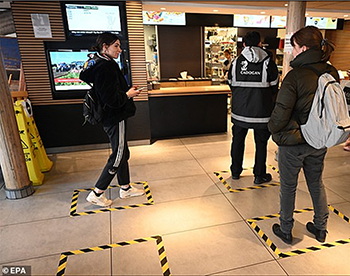Return to Work Plans for Health and Safety
03
February,
2023
3 MINUTE READ

States are in the process of implementing a return to work plan, gradually reopening businesses to stimulate the U.S. economy after a weeks-long shutdown due to COVID-19. Most states have stay-at-home orders that change frequently, while others are extending that order until cases subside substantially, with many schools shut through the remainder of the school year. What are the return to work expectations in business? Whenever the return to work begins for businesses, construction, and other manufacturing, workplaces should have efficient protocols and procedures set in place to ensure health and safety.
Facility Changes
The Occupational Safety and Health Administration and the Centers for Disease Control and Prevention offer workplace guidelines that address proper sanitation and illness response to protect workers and limit the virus' spread. Thousands of essential businesses are operating under the strictest vigilance by scrubbing down facilities, providing personal protective equipment, and adjusting to ensure social distancing. Some workers have begun to return after temporary furloughs, such as at a Boeing facility in Washington. There, the company set up new hand-washing stations, employee monitoring policies, and additional signs as reminders to always follow health and safety guidelines.
"The safety of Boeing employees, their dependents, and visitors to our sites remains a top priority," according to Boeing's statement. "Boeing's Chief Medical Officer and our International Health Services team are continuously tracking health conditions using the guidance of the World Health Organization and the U.S. Centers for Disease Control and Prevention. We continue to adapt and evolve its emergency management procedures to address the ongoing coronavirus outbreak."
Health and Safety Protocols
 Boeing is just one of the dozens of workplaces that are moving forward using smart, cautious plans to get back up to speed. After all, there is no vaccine for COVID-19 and the virus is still claiming lives. Workplaces must have a solid safety plan in place before resuming business. Workplaces that are reopening should still be vigilant in decreasing the spread of COVID-19 through maintaining healthy business operations and a healthy work environment. Here are a few tips workplaces can focus on in return to work COVID-19 prevention plans:
Boeing is just one of the dozens of workplaces that are moving forward using smart, cautious plans to get back up to speed. After all, there is no vaccine for COVID-19 and the virus is still claiming lives. Workplaces must have a solid safety plan in place before resuming business. Workplaces that are reopening should still be vigilant in decreasing the spread of COVID-19 through maintaining healthy business operations and a healthy work environment. Here are a few tips workplaces can focus on in return to work COVID-19 prevention plans:
- Personal protective equipment: Require appropriate PPE in all areas, at all times, such as eye protection, nose and mouth coverings, gloves, and other coverings that limit physical contact. Sanitize and store PPE in a designated area and ensure control over what is accessible and usable.
- Sanitize the space: Workplaces may already have a disinfection protocol; however, hiring a professional third-party cleaning company to completely sanitize the work environment helps ensure all areas are effectively cleaned disinfected. It also provides documentation that the facility has been making solid strides in securing health and safety. Maintain disinfectant protocols as workers return to workstations. Outline procedures and expectations for employee desk cleaning, cleaning working and eating surfaces before and after use, and restroom etiquette.
- Maintain self-distancing: Use social distancing signs and labels to mark 6-foot distances as a visual reminder for workers to maintain safe distances. For example, many facilities are using floor decals, such as dots, Xs, and foot shapes, to highlight safe pedestrian paths and spacing. Create areas for materials passing so that workers do not pass them by hand but instead set them down.
- Monitoring: Each facility can set its own standards for safety monitoring, such as separate entrances and exits for department staff, or evaluation areas for workers entering the building to make sure they have PPE and do not have COVID-19 symptoms.
When rolling out new rules for workers as they return to facilities and warehouses, it is important to convey those rules early and often. Remind workers to wash and disinfect at home, including removing work clothes and washing them promptly. Give workers time to prepare and adjust their workday. Safety managers can reinforce regular safety and new policies with the right tools, including visual communication. Use safety best practices and follow guidance from OSHA, the CDC, and local government.
An effective workplace environmental health and safety strategy helps workplaces manage the most important aspects of a business, whether during a crisis or in day-to-day operation. Get key steps to a successful safety program and more in this free EHS Managers guide.
RELATED RESOURCES

NYC Plans to Remove Old, Misleading Fallout Shelter Signs
Signs that were posted during the Cold War are still up in places around New York City. These signs are old ...
Read
OSHA Lists Top Workplace COVID-19 Violations
OSHA has been busy this year tackling workplace compliance and safety during the coronavirus pandemic. The ...
Read
All EHS Managers Want for Christmas is ...
A list of safety supplies and other gifts that keep on giving for EHS managers. The holidays are here. ...
Read.png)


